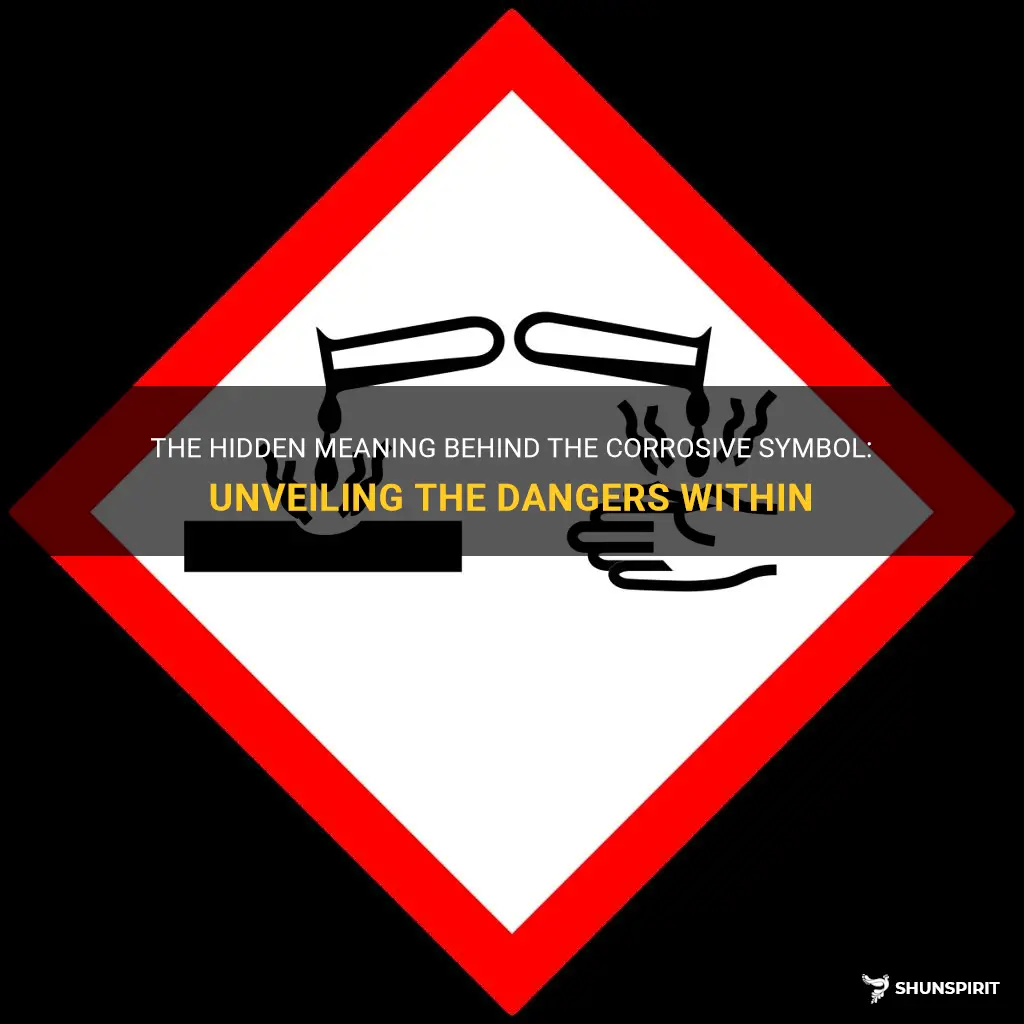
The corrosive symbol is a powerful image that warns individuals of the potential dangers that lie ahead. With its stark black and white color scheme, the symbol immediately catches the eye and commands attention. But what exactly does this symbol mean? What dangers lurk behind it? In this article, we will delve into the corrosive symbol meaning, exploring its origins, its purpose, and the potential risks associated with corrosive substances. Get ready to uncover the secrets hidden behind this striking symbol and gain a deeper understanding of the corrosive world that surrounds us.
What You'll Learn
- What does the symbol for corrosive substances mean?
- What are some examples of substances that are labeled with the corrosive symbol?
- What precautions should be taken when handling or storing corrosive materials?
- How does exposure to corrosive substances affect the human body?
- Are there any specific regulations or guidelines for labeling and handling corrosive materials in different industries?

What does the symbol for corrosive substances mean?
Corrosive substances are chemicals or materials that have the capability to cause severe damage or destruction to other materials they come in contact with. They can corrode, erode, or burn through various materials, including metals, plastics, and human tissue. These substances are typically highly reactive and can pose a significant risk to human health and the environment.
To warn people about the potential dangers of corrosive substances, a specific symbol is used. This symbol is called the corrosive symbol and is internationally recognized. The corrosive symbol consists of a solution dropping down onto a solid material, with an exclamation mark inside a black triangle at the top. The symbol is usually displayed on containers of corrosive substances, such as bottles or drums, and is also present on safety data sheets and hazard labels.
The purpose of the corrosive symbol is to alert individuals to the potential hazards associated with corrosive substances. It serves as a visual cue that the substance inside can cause severe burns or damage upon contact with skin, eyes, or other materials. The symbol is typically accompanied by written warnings, such as "corrosive," "caustic," or "may cause burns," to further emphasize the dangers.
It is important to take the corrosive symbol seriously and exercise caution when handling or working with corrosive substances. Some common examples of corrosive substances include strong acids, strong bases, certain cleaning agents, and battery acid. These substances can cause chemical burns, eye damage, respiratory problems, and other severe health issues.
When working with corrosive substances, it is essential to wear appropriate personal protective equipment, such as gloves, goggles, and protective clothing. It is also crucial to work in a well-ventilated area to minimize the risk of inhaling toxic fumes. Proper storage and handling of corrosive substances are essential to avoid accidents or spills that could lead to injuries or environmental damage.
In case of accidental exposure to a corrosive substance, immediate action should be taken. For contact with the skin, the affected area should be rinsed with copious amounts of water, and medical attention should be sought. If the eyes are affected, they should be rinsed with water for at least 15 minutes while seeking immediate medical help. Inhalation or ingestion of corrosive substances also requires medical attention, and the affected individual should be taken to a healthcare facility as soon as possible.
In summary, the symbol for corrosive substances consists of a solution dropping down onto a solid material, with an exclamation mark inside a black triangle at the top. This symbol is used to warn people about the potential dangers of corrosive substances, which can cause severe burns and damage upon contact. Proper precautions should always be taken when handling or working with corrosive substances to ensure personal safety and prevent accidents.
Exploring Nigerian Symbols: Uncovering the Meanings Behind Rich Cultural Icons
You may want to see also

What are some examples of substances that are labeled with the corrosive symbol?
Corrosive substances are known for their ability to cause damage to living tissues upon contact. They can be classified as either acids or bases, depending on their pH levels. Substances that are labeled with the corrosive symbol can be found in various areas of our daily lives, including household products, industrial chemicals, and laboratory reagents. Here, we will explore some common examples of substances that are labeled with the corrosive symbol.
One of the most well-known and widely used corrosive substances is sulfuric acid. It is commonly used in the manufacturing of fertilizers, dyes, detergents, and various industrial chemicals. Sulfuric acid has a strong affinity for water and can cause severe burns and tissue damage if it comes into contact with the skin or eyes.
Another commonly encountered corrosive substance is hydrochloric acid. It is a strong acid and is often used for cleaning metals, removing rust, and adjusting the pH levels in swimming pools. Hydrochloric acid can cause severe burns, eye damage, and respiratory irritation.
Caustic soda, or sodium hydroxide, is a strong base that is highly corrosive. It is widely used in the production of paper, textiles, soaps, and detergents. Caustic soda can cause severe burns, eye damage, and can be harmful if ingested or inhaled.
Other examples of substances that are labeled with the corrosive symbol include nitric acid, phosphoric acid, potassium hydroxide, and ammonia. These substances are used in various industrial processes such as metal etching, fertilizers production, and the manufacturing of household cleaning products.
It is important to handle all corrosive substances with extreme caution and to follow proper safety procedures when working with them. This includes wearing appropriate protective equipment, such as gloves and goggles, and working in well-ventilated areas.
Furthermore, it is essential to properly store and label corrosive substances to prevent accidents and ensure the safety of everyone in the vicinity. Containers should be securely closed and stored in areas where they are not accessible to unauthorized personnel. Additionally, it is vital to make sure that corrosive substances are kept away from incompatible materials to prevent dangerous reactions.
In conclusion, substances labeled with the corrosive symbol are commonly encountered in various aspects of our daily lives. Sulfuric acid, hydrochloric acid, caustic soda, and other substances are used in industries, laboratories, and even in household products. It is crucial to exercise caution when handling these substances to prevent accidents and ensure personal safety.
Decoding the Meaning Behind Biker Symbols: Unveiling the Secret Language of Motorcycle Clubs
You may want to see also

What precautions should be taken when handling or storing corrosive materials?
Corrosive materials are substances that can cause severe damage to other materials or living tissues through a chemical reaction. They often have the ability to corrode metals, burn skin or eyes, and release toxic fumes when exposed to air or water. Handling and storing corrosive materials requires specific precautions to ensure the safety of individuals and the surrounding environment. Here are some essential precautions to consider:
- Personal protective equipment (PPE): When handling corrosive materials, it is crucial to wear appropriate PPE to protect yourself from potential hazards. This could include gloves, goggles, a lab coat or apron, and a respirator if necessary. PPE should be made of suitable protective materials that are resistant to the corrosive substance being used.
- Proper ventilation: Corrosive materials often release toxic fumes or gases, which can be harmful if inhaled. It is essential to work in a well-ventilated area or utilize fume hoods to remove any potentially harmful vapors. Ensuring adequate airflow helps reduce the risk of exposure to corrosive substances.
- Storage: Corrosive materials should be stored in a secure, designated area that is well-ventilated and away from incompatible substances. Containers holding these materials should be sturdy and leak-proof to prevent spills or accidents. Labeling containers with clear and visible markings indicating the contents and any potential hazards is also crucial for safety.
- Separation of incompatible substances: Keep in mind that corrosive materials may react with other substances, leading to dangerous reactions or releases of heat, toxic gases, or explosions. It is imperative to separate corrosive materials from incompatible substances, such as flammable or combustible materials, oxidizers, or reactive chemicals. Reference material safety data sheets (MSDS) to identify incompatible substances and follow the recommended storage guidelines.
- Handling and transport: When handling corrosive materials, use appropriate tools and equipment designed for this purpose. Avoid using containers or tools made of materials that can react with or be damaged by the corrosive substance. During transportation, secure containers properly to prevent spills or leaks. If necessary, use secondary containment, such as spill trays or drip pans, to catch and contain any potential leaks.
- Emergency preparedness: In the event of a spill, leak, or accident involving corrosive materials, it is important to have an emergency response plan in place. This may include evacuation procedures, first aid measures, and contacting proper authorities or emergency services. Ensuring that employees are trained in emergency response procedures can help prevent or minimize the impact of accidents.
Remember, when working with corrosive materials, always follow specific guidelines provided by manufacturers, safety data sheets, and relevant regulations to ensure the highest level of safety. By taking necessary precautions, you can minimize the risk of accidents, injuries, or environmental damage associated with handling and storing corrosive materials.
The Symbolic Meaning of a Bluebird: A Guide to Understanding its Significance
You may want to see also

How does exposure to corrosive substances affect the human body?
Exposure to corrosive substances can have severe effects on the human body. Corrosive substances are chemicals that can cause damage to living tissue upon contact. These substances have the ability to eat away at materials through a chemical reaction, which can be highly dangerous when they come into contact with the human body.
When corrosive substances come into contact with the skin, they can cause burns and severe damage to the superficial layer of the skin, known as the epidermis. Depending on the strength and duration of the exposure, the burns can range from mild to severe, and even result in the destruction of skin tissue. The severity of the burn depends on various factors, including the concentration of the corrosive substance and the duration of the exposure.
In addition to skin burns, corrosive substances can also cause damage to the eyes. When these substances come into contact with the eyes, they can cause burns and lead to vision impairment or even blindness. The eyes are particularly susceptible to damage from corrosive substances, as the delicate tissues are easily affected by chemical reactions.
Moreover, inhaling corrosive substances can have detrimental effects on the respiratory system. When these substances are inhaled, they can cause irritation and damage to the lining of the respiratory tract, including the lungs. This can lead to coughing, difficulty in breathing, and in severe cases, respiratory failure. Prolonged exposure to corrosive substances can also increase the risk of developing respiratory conditions such as asthma or chronic obstructive pulmonary disease (COPD).
Ingesting a corrosive substance can be particularly dangerous, as it can cause damage to the digestive system. When these substances come into contact with the tissues of the mouth, esophagus, or stomach, they can cause chemical burns, leading to pain, difficulty in swallowing, and even perforation of the digestive tract. Ingesting corrosive substances can be life-threatening and immediate medical attention is required.
The severity of the effects of exposure to corrosive substances depends on various factors, including the concentration of the corrosive substance, the duration of exposure, and the individual's overall health. It is essential to take precautionary measures when working with or handling corrosive substances to minimize the risks of exposure. This includes wearing appropriate protective clothing, such as gloves and goggles, and ensuring proper ventilation in areas where corrosive substances are used.
In conclusion, exposure to corrosive substances can have severe effects on the human body. These substances can cause burns and damage to the skin, eyes, respiratory system, and digestive system. Immediate medical attention is necessary if exposure to corrosive substances occurs to prevent further damage and complications. It is important to handle these substances with caution and take necessary precautions to avoid exposure and minimize the risks to human health.
The Symbolic Meaning of the Triangle in Physics: Unveiling its Significance
You may want to see also

Are there any specific regulations or guidelines for labeling and handling corrosive materials in different industries?
Corrosive materials are substances that have the ability to cause damage or destruction to other materials or living organisms through chemical reaction. They can be found in various industries and are typically labeled and handled differently to ensure safety and prevent accidents.
In order to regulate the labeling and handling of corrosive materials, different industries follow specific guidelines and regulations. These guidelines are put in place to protect workers, the environment, and the general public from the potential hazards associated with these substances.
One such industry that deals with corrosive materials is the manufacturing industry. Manufacturers are required to properly label and handle corrosive materials in accordance with the Occupational Safety and Health Administration (OSHA) guidelines. OSHA requires manufacturers to properly label containers of corrosive materials with clear and visible warning labels. These labels must include information about the specific hazards associated with the material and the necessary precautions to prevent accidents or injuries.
The transportation industry also has regulations in place for the labeling and handling of corrosive materials. The Department of Transportation (DOT) requires that all containers of corrosive materials be properly labeled with hazard class labels. These labels provide important information about the material, such as its corrosive properties and the necessary precautions for handling and transporting it safely.
The healthcare industry is another sector that deals with corrosive materials, particularly in laboratories and medical facilities. In this industry, the handling and labeling of corrosive materials are regulated by various organizations, such as the Centers for Disease Control and Prevention (CDC) and the World Health Organization (WHO). These organizations provide guidelines for the safe handling and storage of corrosive materials in healthcare settings, including the use of personal protective equipment and proper storage techniques.
In addition to regulations and guidelines, industries that deal with corrosive materials often implement specific safety protocols and training programs to ensure that workers are well-equipped to handle these substances safely. These protocols may include procedures for handling, storing, and disposing of corrosive materials, as well as emergency response plans in case of accidents or spills.
It is important to note that the specific regulations and guidelines for labeling and handling corrosive materials may vary depending on the industry and the country in which the materials are being used or transported. It is crucial for businesses and individuals to familiarize themselves with the applicable regulations and guidelines in order to ensure compliance and uphold safety standards.
In conclusion, the labeling and handling of corrosive materials in different industries are regulated by specific guidelines and regulations. These guidelines are aimed at protecting workers, the environment, and the general public from potential hazards. It is important for industries and individuals to adhere to these guidelines and take necessary precautions to ensure the safe handling and transportation of corrosive materials.
The Power of Symbols: Exploring the Meanings Behind Symbols That Represent Growth
You may want to see also
Frequently asked questions
The corrosive symbol, also known as the Corrosion pictogram, is a warning sign that is used to indicate the potential dangers of a corrosive substance. It is typically depicted as a skull and crossbones symbol with an acidic drop. The symbol is used to alert individuals to the fact that the substance can cause serious damage to skin, eyes, and other materials. It serves as a visual reminder to handle the substance with extreme caution and to take appropriate safety measures when working with corrosive materials.
Corrosive substances pose a number of risks, which is why the corrosive symbol is used to alert individuals to these dangers. These substances have the potential to cause severe burns or irreversible damage to the skin, eyes, and respiratory system. Inhalation of corrosive vapors or aerosols can also cause respiratory distress or damage to the lungs. In addition, corrosive substances can eat away at materials such as metals, plastics, and fabrics, leading to structural damage or the release of toxic gases. It is important to handle these substances with care and to follow appropriate safety protocols to minimize the risks associated with them.
Corrosive substances should be stored in a cool, dry, and well-ventilated area to minimize the risk of chemical reactions or spills. It is important to keep these substances away from ignition sources and incompatible materials, as they can react violently when exposed to certain substances or conditions. When handling corrosive substances, it is essential to wear appropriate personal protective equipment, such as gloves, goggles, and a lab coat, to protect against contact with the skin, eyes, and clothing. It is also important to use appropriate containment measures, such as spill kits and secondary containment, to prevent leaks or spills from spreading and causing further damage.
If you or someone else is exposed to a corrosive substance, it is important to take immediate action to minimize the effects of the exposure. For skin contact, quickly remove any contaminated clothing and rinse the affected area with copious amounts of water for at least 15 minutes. Seek medical attention if necessary. For eye exposure, immediately flush the eyes with water for at least 15 minutes and seek medical attention. If the corrosive substance is inhaled, move to a well-ventilated area and seek medical assistance. It is important to always follow the safety procedures and protocols established by your workplace or the manufacturer when responding to a corrosive substance exposure.







